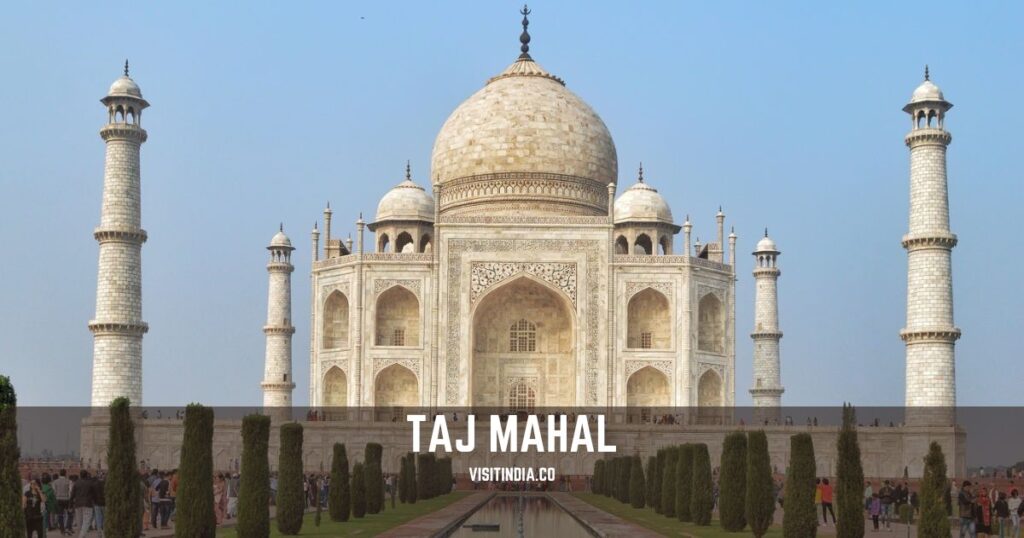Taj Mahal Timings, Entry Fee, History and Facts
The Taj Mahal, a symbol of love and architectural brilliance, continues to captivate visitors from across the globe. As one of India’s most iconic landmarks, this UNESCO World Heritage Site offers a mesmerizing glimpse into Mughal history and craftsmanship.

Whether you’re planning your visit or simply curious about its fascinating past, this guide has you covered. Discover the Taj Mahal’s entry fee details, explore its visiting hours, and learn intriguing facts about its creation and legacy.
From its breathtaking design to the stories behind its construction, this article will provide everything you need to appreciate the beauty and significance of this timeless wonder.
See also: Best Places to Visit in India
Taj Mahal Entry Fees and Timings
The Taj Mahal operates from 30 minutes before sunrise until 30 minutes before sunset, except on Fridays. Entry fees are categorized as follows:
- Indian Nationals: ₹50 per person.
- Citizens of SAARC and BIMSTEC countries: ₹540 per person.
- Foreign Tourists: ₹1,100 per person.
- Children below 15 years: Free entry for both domestic and foreign visitors.
An additional ₹200 is charged for those wishing to enter the main mausoleum. Tickets can be purchased online through the official website or at designated ticket counters near the monument.
Best Time to Visit Taj Mahal
Experiencing the Taj Mahal at sunrise offers a serene atmosphere and a mesmerizing play of colors on the marble façade. Arriving early not only provides a tranquil setting but also helps in avoiding the midday heat and larger crowds.
However, during the winter months (December to February), morning fog can obscure views, so late afternoon visits might be preferable during this period. The monument is closed on Fridays for general viewing, so plan your visit accordingly.
Historical Significance of Taj Mahal
The Taj Mahal stands as a breathtaking testament to love and devotion. Built by Mughal Emperor Shah Jahan in 1632 AD, it was commissioned as a mausoleum for his beloved wife, Mumtaz Mahal, who passed away during childbirth.
This iconic structure is more than just an architectural masterpiece; it encapsulates the deep sorrow and enduring love of an emperor for his queen. Its construction marked a defining moment in Mughal history, showcasing the empire’s unparalleled mastery of art, architecture, and engineering.
Situated in Agra, the Taj Mahal reflects the zenith of Mughal creativity and innovation during a period of cultural flourishing. It was built during a time when the empire was one of the most powerful and prosperous in the world.
The construction process spanned approximately 20 years, involving thousands of artisans, masons, and craftsmen from India and beyond. As a cultural icon, the Taj Mahal is not only a memorial but also a representation of the Mughal era’s opulence and artistic vision, making it an enduring symbol of India’s rich history.
Architectural Marvel of Taj Mahal
The Taj Mahal is an unparalleled gem of Mughal architecture, celebrated for its striking symmetry, elegant domes, and serene gardens. Designed to epitomize heavenly perfection, every detail of the structure reflects meticulous planning and masterful execution.
The central dome, soaring at 73 meters, is flanked by four slender minarets, each slightly tilted outward to protect the main structure from potential collapse during earthquakes.
Constructed from pristine white marble sourced from Makrana in Rajasthan, the Taj Mahal also features intricate inlay work of precious and semi-precious stones like jade, turquoise, and lapis lazuli. These materials create floral motifs that add vibrancy and intricacy to the monument’s surfaces.
The Charbagh garden, a quintessential feature of Mughal landscaping, surrounds the Taj, dividing the space into four symmetrical quarters. With a central reflecting pool, it mirrors the Taj Mahal, creating an ethereal visual effect.
Engineering marvels such as the use of a wooden foundation, which absorbs and dissipates moisture from the nearby Yamuna River, and an optical illusion that makes the dome appear larger when viewed from the entrance, further highlight the sophistication of the structure.
This careful balance of functionality and aesthetics ensures the Taj Mahal’s enduring legacy as one of the wonders of the world.
Fun Facts About Taj Mahal
The Taj Mahal is a masterpiece of human effort and artistry, and its construction involved an astounding workforce of over 20,000 artisans, craftsmen, and laborers. These skilled individuals worked tirelessly for 22 years to bring Emperor Shah Jahan’s vision to life.
Experts were brought in from across the Mughal Empire and even beyond, including regions like Persia and Central Asia, ensuring a blend of the finest skills and techniques of the era.
There are also many myths and legends surrounding this iconic monument. One of the most popular tales suggests that Shah Jahan ordered the hands of the artisans to be cut off after the Taj Mahal was completed to ensure that no structure of similar beauty could ever be built again. While there’s no historical evidence to confirm this, the story adds an air of intrigue to the monument’s history.
A lesser-known feature of the Taj Mahal is the optical illusion in its design. The minarets, which appear perfectly straight, are actually slightly tilted outward. This ingenious engineering choice ensures they would fall away from the main dome in the event of an earthquake, protecting the central structure.
Additionally, the calligraphy adorning the main entrance and other parts of the Taj appears uniform from any distance due to the masterful adjustment of letter sizes—a subtle yet incredible design choice.
Final Thoughts on Taj Mahal
The Taj Mahal stands as a timeless testament to love, art, and history, leaving an indelible impression on all who visit. From its meticulously planned architecture to the profound stories woven into its marble, it continues to inspire awe and wonder.
As you plan your visit, keeping its timings, entry fees, and fascinating history in mind ensures a memorable journey into one of the world’s most cherished monuments. Let the beauty and legacy of this wonder remind us of the enduring power of human creativity and devotion.





